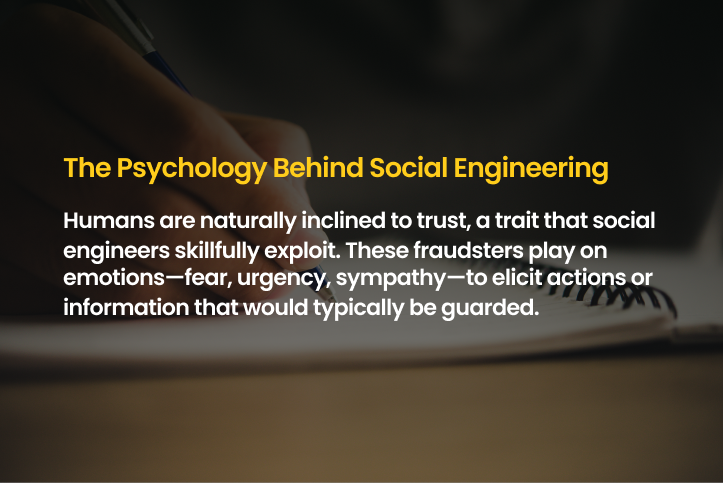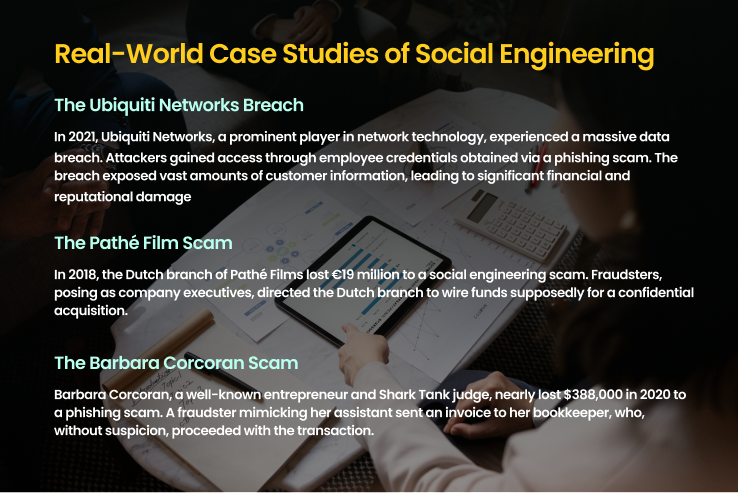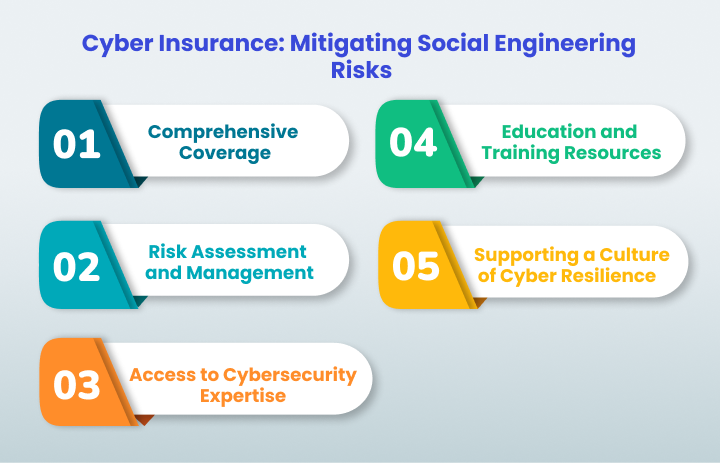The only truly secure system is one that is powered off, cast in a block of concrete and sealed in a lead-lined room with armed guards – and even then I have my doubts. This hyperbolic quote by Gene Spafford, a pioneer in the field of computing and network security, humorously underscores the pervasive threats in cyberspace.
Among these, social engineering emerges as a distinctly human loophole in the digital security chain, exploiting not system vulnerabilities, but human ones.
Imagine a bustling startup, XYZ Corp, on the brink of a major breakthrough. One day, an email seemingly from the CEO asks the finance department to wire funds for a confidential acquisition.
The email is convincing, complete with the CEO’s signature and company letterhead. No one questions it; the transfer goes through. Days later, the deception unravels. The CEO had made no such request.
The funds, and perhaps the future of XYZ Corp, vanished into the ether. This incident is not just a cautionary tale but a stark reality for many in today’s interconnected world, where social engineering frauds are increasingly sophisticated.
Social engineering, in essence, is the art of manipulating individuals into surrendering confidential information or performing actions that may result in a security breach. In the realm of cyber insurance, it represents a complex risk, intertwining human psychology with technological vulnerabilities.
As we delve deeper into the nuances of social engineering, real-world case studies, and the protective layer cyber insurance offers, remember the tale of XYZ Corp. It serves as a potent reminder of the fragility of trust in the digital age and the paramount importance of vigilance and protection in all its forms.
Understanding Social Engineering
At its core, social engineering is a sophisticated form of deception, aiming to manipulate individuals into divulging sensitive information or performing actions that compromise security. Unlike traditional hacking, which often relies on technical vulnerabilities, social engineering exploits the most unpredictable element of cybersecurity: the human psyche.
The Psychology Behind Social Engineering

Humans are naturally inclined to trust, a trait that social engineers skillfully exploit. These fraudsters play on emotions—fear, urgency, sympathy—to elicit actions or information that would typically be guarded.
For instance, by impersonating authority figures or trusted entities, attackers create scenarios where the target feels compelled to comply.
Recent Statistics

The prevalence of social engineering attacks is alarming. According to the FBI’s 2021 Internet Crime Report, phishing and similar frauds topped the list of cybercrimes, with reported losses exceeding $4.2 billion in the United States alone.
This staggering figure underscores the effectiveness of such tactics and the critical need for awareness and protection.
Real-World Case Studies of Social Engineering

To understand the threat landscape, let’s examine some real-world incidents:
Case Study 1: The Ubiquiti Networks Breach
In 2021, Ubiquiti Networks, a prominent player in network technology, experienced a massive data breach. Attackers gained access through employee credentials obtained via a phishing scam. The breach exposed vast amounts of customer information, leading to significant financial and reputational damage.
Case Study 2: The Pathé Film Scam
In 2018, the Dutch branch of Pathé Films lost €19 million to a social engineering scam. Fraudsters, posing as company executives, directed the Dutch branch to wire funds supposedly for a confidential acquisition. The sophisticated deception went unnoticed until the damage was irreparable.
Case Study 3: The Barbara Corcoran Scam
Barbara Corcoran, a well-known entrepreneur and Shark Tank judge, nearly lost $388,000 in 2020 to a phishing scam. A fraudster mimicking her assistant sent an invoice to her bookkeeper, who, without suspicion, proceeded with the transaction.
Vigilance and quick action recovered the funds, highlighting the importance of awareness and verification processes.
The Role of Cyber Insurance in Mitigating Social Engineering Risks

While cyber insurance does not prevent attacks, it can mitigate the financial impact, allowing businesses to recover more swiftly. It also often comes with resources to improve security postures, such as access to cybersecurity experts and education on emerging threats.
1. Comprehensive Coverage
Cyber insurance policies are designed to cover a range of incidents stemming from social engineering tactics, including phishing, spear-phishing, pretexting, and more.Coverage can extend to direct financial losses incurred through fraudulent transactions, ransom payments in the case of ransomware attacks, and even the costs associated with system downtimes.
Moreover, these policies often cover the expenses related to legal fees, customer notification, and services such as credit monitoring for affected customers, thereby mitigating the broader financial and reputational impacts of an attack.
2. Risk Assessment and Management
Many cyber insurance providers offer risk assessment services as part of their policy packages. These assessments can identify vulnerabilities within an organisation’s digital and human elements, providing valuable insights into potential security gaps that could be exploited via social engineering.
By understanding these vulnerabilities, businesses can take preemptive steps to fortify their defences, thus reducing the likelihood of a successful attack.
3. Access to Cybersecurity Expertise
Access to a network of cybersecurity experts is another significant benefit provided by cyber insurance policies. In the event of a social engineering attack, insurers can connect policyholders with professionals who specialise in cyber incident response, forensic analysis, and legal matters related to cyber law.
This immediate access to expertise can drastically reduce the time and resources required to respond to and recover from an incident.
4. Education and Training Resources
Education is a critical component of cybersecurity, particularly in defending against social engineering attacks. Cyber insurance providers often furnish policyholders with training resources and programs designed to educate employees about the nature of social engineering threats and best practices for prevention.
These training programs can include simulated phishing exercises, workshops, and e-learning modules, all aimed at heightening awareness and reducing the likelihood of employee error or oversight.
5. Supporting a Culture of Cyber Resilience
By integrating cyber insurance into their cybersecurity strategy, organisations can foster a culture of cyber resilience. This culture is underpinned by a comprehensive approach to risk management, which combines insurance protection with proactive cybersecurity measures.
It acknowledges that while it may not be possible to prevent all attacks, minimising risk and ensuring rapid recovery are achievable goals. In this context, cyber insurance acts not just as a financial safety net but as a catalyst for adopting and maintaining strong cybersecurity practices.

Limitations of Cyber Insurance
It’s crucial to understand that cyber insurance does not cover all aspects of cyber risk. Policies often have exclusions and may not cover losses related to intellectual property theft or reputational damage. Thus, insurance should be one element of a comprehensive risk management strategy.
Integrating Cyber Insurance with Cybersecurity Measures
Cyber insurance and cybersecurity measures are most effective when integrated into a cohesive strategy. Businesses and individuals should adopt a layered defence approach, combining robust security practices with insurance coverage to safeguard against the multifaceted threats posed by social engineers.
Best Practices to Follow

Implementing effective cybersecurity measures is paramount in preventing social engineering attacks. Key practices include:
- Education and Training: Regularly train employees to recognize and respond to phishing attempts and other social engineering tactics.
- Verification Procedures: Establish protocols for verifying requests, particularly those involving financial transactions or sensitive information.
- Secure Communication Channels: Use encrypted communication methods and authenticate emails to protect against interception and forgery.
Conclusion and Mitigation Strategies
The tales of XYZ Corp, Ubiquiti Networks, Pathé Films, and Barbara Corcoran serve as stark reminders of the vulnerabilities that social engineering exploits. In an era where trust can be both a strength and a weakness, understanding the nature of these threats and preparing accordingly is crucial.

